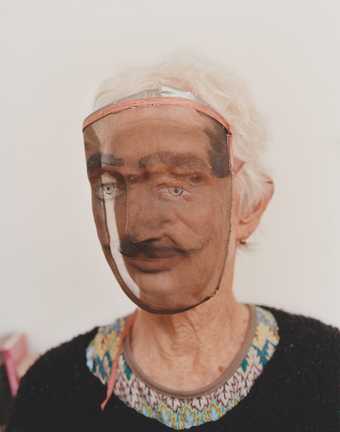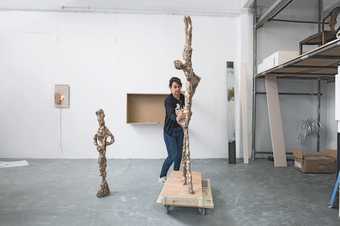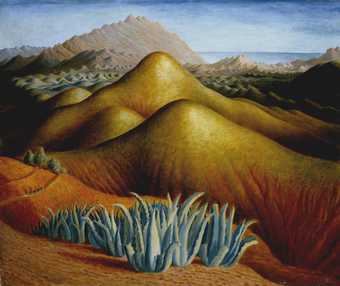‘If life has a base that it stands upon, if it is a bowl that one fills and fills and fills – then my bowl without a doubt stands upon this memory. It is of lying half asleep, half awake, in bed in the nursery at St Ives. It is of hearing the waves breaking, one, two, one, two, and sending a splash of water over the beach; and then breaking, one, two, one, two behind a yellow blind. It is of hearing the blind draw its little acorn across the floor as the wind blew the blind out. It is of lying and hearing this splash and seeing this light, and feeling, it is almost impossible that I should be here; of feeling the purest ecstasy I can conceive.’
— Virginia Woolf, ‘A Sketch of the Past’ (1939)
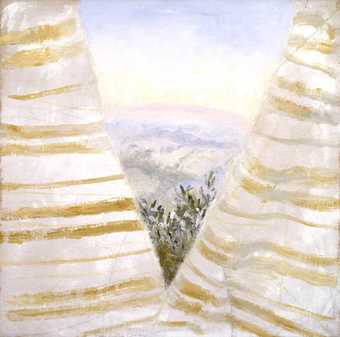
Winifred Nicholson
Glimpse Upon Waking (1976)
Tate
Virginia Woolf (née Stephen, 1882–1941) spent every summer until she was 13 in St Ives, Cornwall. She and her family stayed at Talland House, from where she could see Godrevy Lighthouse across the bay – the lighthouse which, over 30 years later, would become the muse for her celebrated novel To the Lighthouse (1927). When Woolf’s mother, Julia Stephen, passed away in 1895, the family ceased their annual trips to Cornwall. Woolf didn’t return to St Ives until 1905 – one year after the death of her father, Sir Leslie Stephen – when she ventured back with her sister, the painter Vanessa Bell.
Throughout their lives, Woolf and Bell shared a mutually influential relationship, inspiring one another’s writing and painting in turn. Woolf cultivated significant relationships with many other artists and writers (among them Dorothy Brett, Dora Carrington, Nina Hamnett, Katherine Mansfield, Gwen Raverat, Vita Sackville-West and Ethel Sands) with whom she shared ideas and passions. Her writing would also influence future generations of artists and writers – both directly and indirectly – including Ithell Colquhoun, Gluck, Winifred Nicholson, Penny Slinger and many more. The legacy of these numerous reciprocally beneficial relationships is precisely what Woolf was referring to when she said that, as creative women, we ‘think back through our mothers’ – and follows her notion that: ‘Masterpieces are not single and solitary births; they are the outcome of many years of thinking in common, of thinking by the body of the people, so that the experience of the mass is behind the single voice.’
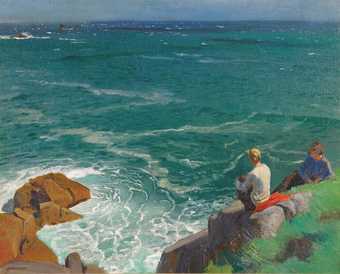
Laura Knight, A Green Sea 1917, 61 × 76 cm
© Reproduced with permission of The Estate of Dame Laura Knight, DBE RA 2018. All rights reserved. Image courtesy Sotheby's
For Woolf, St Ives – and Talland House in particular – became the site where, for the duration of her life, she located happiness and her stimulation to write. As she revealed in her posthumously published autobiographical writings, Moments of Being: ‘I could fill pages remembering one thing after another. All together made the summer at St Ives the best beginning to a life conceivable.’ The house and the backdrop of ocean and landscape beyond it would be repeatedly invoked in her novels – most notably in The Voyage Out, Jacob’s Room, To the Lighthouse and The Waves.

Ithell Colquhoun, Stalactite 1962, oil paint on board, 147.4 × 35 cm
© by kind permission of the Noise Abatement Society, Samaritans and Spire Healthcare. Image courtesy Richard Shillitoe, photo: Karen Ross
Woolf frequently overlaid her metaphors or ideas, deliberately pitching them against one another. She called this a ‘harlequinade’ – an assortment of conflicting allusions which, in their different directions and tempos, drove her narratives forward. The most enduring of these oppositions are perhaps those that she set up between the home and room, and the land and sea (as discussed by Avril Horner and Sue Zlosnik in Landscapes of Desire: Metaphor in Modern Women's Fiction, 1990). Woolf also plied these relationships to demonstrate her unwaveringly feminist perspective: in both her essays and her fiction, Woolf consistently built up and shaped different ways for women to be in, or with, the home and nature.
Woolf’s feminism sought alternatives to masculine depictions of masculine experiences. In her writing, she strove towards a multiplicity of narrators in place of one unified authorial voice, unpicking the idea of a monolithic narrating self – what she called the ‘egotistical I’ – which, for her, obscured both women and the natural world. As she writes in A Room of One’s Own (1929): ‘But after reading a chapter or two a shadow seemed to lie across the page. It was a straight dark bar, a shadow shaped something like the letter “I”. One began dodging this way and that to catch a glimpse of the landscape behind it. Whether that was indeed a tree or a woman walking, I was not quite sure.’
From an early age Woolf had strong ties to groups such as the Suffrage Movement, the National Union of Women’s Suffrage Societies, and the World Women Organisation. It was during her summers in St Ives that she first met Joseph Wolstenholme, the brother of Elizabeth Wolstenholme Elmy, one of the 19th century’s most active workers for the women’s cause. Joseph was a friend of Woolf’s father and a significant member of the Manchester National Society for Women’s Suffrage, the most radical of the suffrage societies, which had been founded by his sister in 1865. He spent many a summer in St Ives, where he enthused the young Stephen sisters with his political advocacy.
Woolf’s feminism began in Talland House. And it is significant that when she devises a metaphor for a generation of women setting up professional lives, it is that of a room – a space that becomes synonymous with financial independence. A Room of One’s Own is a different version of the rooms where ‘women have sat indoors all these millions of years, so that by this time their very walls are permeated by their creative force’. And she goes on: ‘The rooms differ so completely; they are calm or thunderous; open to the sea, or, on the contrary, give on to a prison yard; are hung with washing; or alive with opals and silks; are hard as horsehair or soft as feathers – one has only to go into any room in any street for the whole of that extremely complex force of femininity to fly in one’s face.’
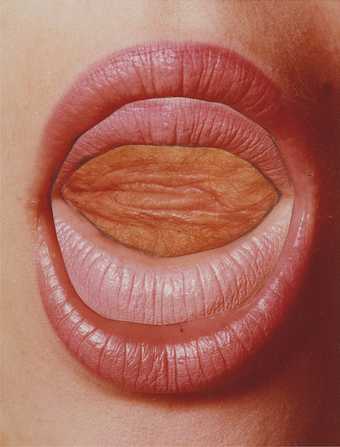
Penny Slinger, Read My Lips 1973, photo collage, 22.4 × 17.3 cm
© Penny Slinger, image courtesy The Roland Penrose Collection
The room then, for Woolf, is a site of potential autonomy and liberation. But it is also symbolic of the physical and psychological constriction of women, from which liberation is necessary – ‘I thought how unpleasant it is to be locked out; and then I thought how it is worse, perhaps, to be locked in.’ Her re-appropriation of the room is the foundation of her feminist aspirations. Numerous other writers and artists, of course, sought – and still seek – similar emancipation, many along lines of exploration comparable to Woolf’s. Charlotte Perkins-Gilman’s 1892 novella The Yellow Wall-Paper is a stark description of the ‘rest cure’ – a 19th-century ‘treatment’ for ‘hysteric’ women (including Perkins-Gilman and Woolf) that involved enforced domestic isolation. Visual artist Tina Keane’s Faded Wallpaper 1986–8, meanwhile, examines similar ideas around isolation, domesticity and the effects of quieting and constraining women’s creativity.
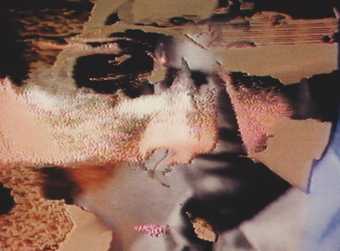
Film still from Tina Keane's Faded Wallpaper 1988, 16mm film/U-matic tape transferred to digital, colour, sound, 20 minutes
© Tina Keane, image courtesy England & Co
Women artists have depicted this struggle in various other ways, too – and there are countless paintings of still lifes on windowsills: a means for women to paint what the academy classified as their rightful, private domain, while covertly revealing a landscape beyond. Reminiscent of Woolf’s opposing metaphors of room and nature, these works situate their creator inside a room while defiantly looking beyond it. Both Wilhelmina Barns-Graham and Gwen John also enact this tension in depictions of their own studios – rooms in which the ambiguity of constraint and autonomy is in constant tension.
For Woolf, there were at least two kinds of equality: the kind in which women gained admission into the world of men (the vote, access to education, financial independence etc), which she strove, compellingly, to attain; and another kind, perhaps more difficult to grasp, which involved remodelling the very foundations of society and redefining the terms in which value itself is assigned – the generation of a new and parallel language or way of being, the charting of a new territory. She describes these differences in types of equality in her 1931 essay ‘Professions for Women’, published two years after A Room of One’s Own and 13 years after (some) women were granted the right to vote: ‘You have won rooms of your own in the houses hitherto exclusively owned by men ... But this freedom is only a beginning; the room is your own, but it is still bare ... With whom are you going to share it, and upon what terms?’
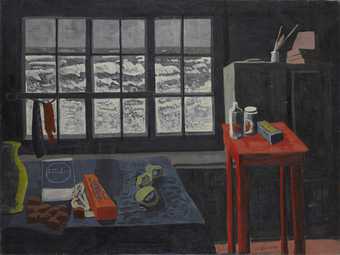
Wilhelmina Barns-Graham, The Blue Studio c.1947–8, oil paint on canvas, 91 × 122 cm
© Wilhelmina Barns-Graham Trust, image courtesy the Fleming-Wyfold Art Foundation
In Woolf, the room becomes a metaphor for autonomy and choice within patriarchal limits, a sort of reclamation of the room’s function to contain. Landscape, however, becomes a metaphor for freedom and power beyond the realms of existing culture. As writer Eleanor Munro describes it in her Originals: American Women Artists (1979): ‘now, the thing about emptiness is that one can fill it: an empty landscape, an empty paper.’ Allusions to an open landscape or unchartered zone allowed Woolf to ‘take my mind out of its iron cage and let it swim’, as she wrote in her diary in 1920. This scenario allows her to both write and enact a different way of being, a real-life dodging of that ‘straight dark bar ... the letter “I”’ that eclipsed both woman and landscape. In her first novel, The Voyage Out (1920), Woolf develops this metaphor even further, actually equating nature with women’s freedom through her protagonist Rachel’s description of walking outside alone: ‘I love the freedom of it – it’s like being the wind or the sea.’
It is through writing landscape, then, and particularly the sea, that Woolf is provided with the possibilities for a future self that is outside of existing societal bounds. These possibilities, which rebuff the cultural constructions of gender, are attached to the unknown and the wild. That is not to say that woman herself is wild or unknown – or that ‘woman’ equates in any way with ‘nature’ – but rather that articulating a desire for woman’s sexual, social and artistic freedom depended on suggesting something that was not yet known. As philosopher and novelist Catherine Clément suggests in The Newly Born Woman (1975): ‘somewhere every culture has an imaginary zone for what it excludes’.
Throughout her writing, Woolf’s frequent oscillation between room and landscape (or seascape) metaphors enacts a conspicuous seesaw between the different types of equality she sought, a strategy that many other artists and writers shared, and continue to share. The power of her approach is that it is able to uncover that which it seeks to sidestep, while performing that sidestep. As Woolf comments in Three Guineas (to her male peers this time): ‘Though we see the same world, we see it through different eyes. Any help we can give you must be different from that you can give yourselves, and perhaps the value of that help may lie in the fact of that difference.’
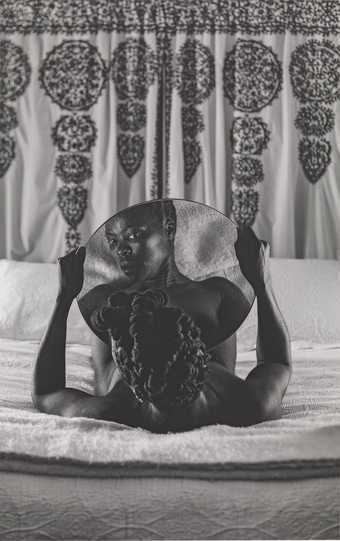
Zanele Muholi, Bona, Charlottesville 2015, photograph, gelatin silver print on paper, 60 × 50.3 cm
© Zanele Muholi, courtesy Tate Photography
Virginia Woolf: an exhibition inspired by her writings, curated by Laura Smith, Exhibitions & Displays Curator, Tate St Ives, 10 February – 29 April. The exhibition tours to Pallant House, Chichester, 26 May – 16 September and The Fitzwilliam Museum, Cambridge, 2 October – 9 December.

